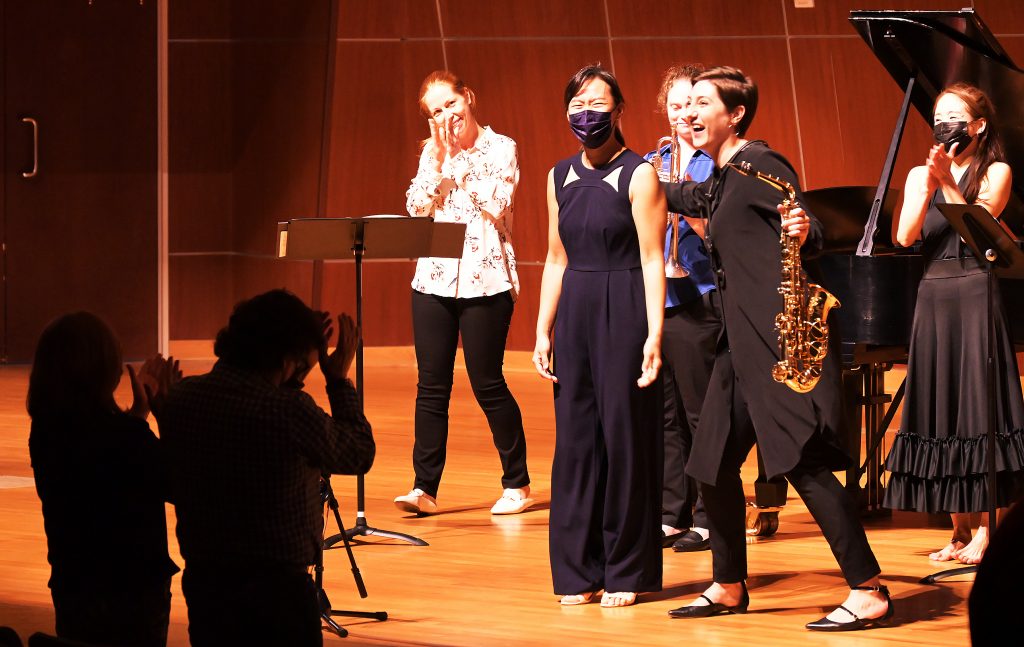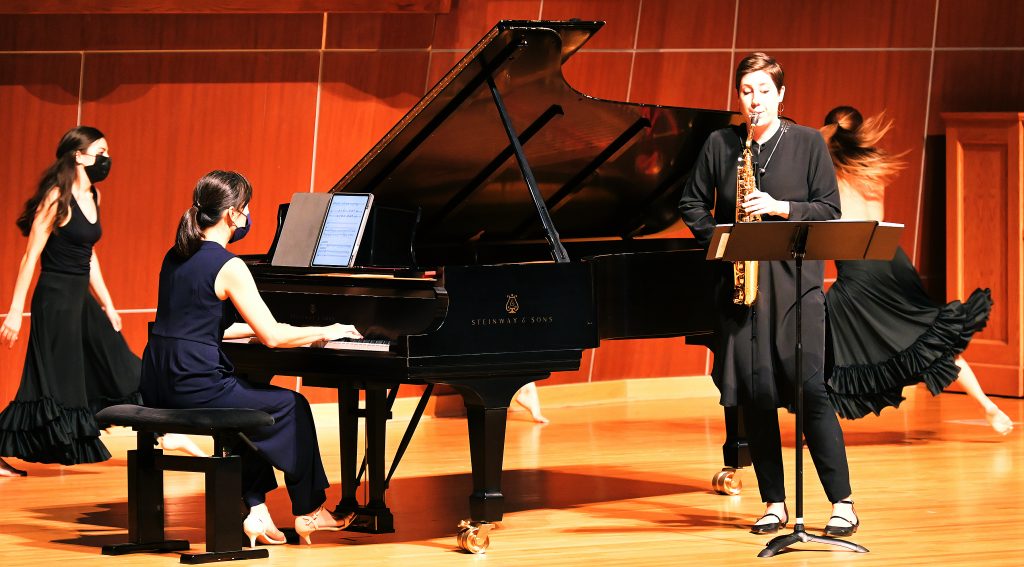Music performances return to Recital Hall
By Kayzee Orallo
Bridge contributing writer
Originally published in the print edition on Friday, Nov. 19, 2021
One of the campus adaptations to a somewhat normal college experience includes a move back onto the stage for live performances.
“Since March 2020, there have been no performances of any kind, so this is our first year back doing anything,” Texas A&M International University Department of Fine and Performing Arts Chair James Moyer said.

Assistant Professor of music Sarah Hetrick reacts to receiving a standing ovation inside the Center for the Fine and Performing Arts Recital Hall on Oct. 29 as part of the returning recitals.
Before, band performances completely stopped, while recitals transpired exclusively for judges; the virus caused the dismissal of most concerts.
“When you put a lot of people close together and start playing, especially trumpet and flute and clarinet players, they’re blowing that stuff around,” Moyer said. “It is not creating a very safe environment, so we just didn’t try last year.”
While most understood the need for caution, that came with its own price tag.
“It made me feel sad,” cellist Melissa Irigoyen said. “My whole life revolves around performances, gatherings and rehearsals, so [the pandemic] basically took a very important aspect of my life and my major.”
Now, restrictions for COVID-19 are implemented during these gatherings for musician and crowd safety. These precautions include skipping a chair, masks stations, hand sanitizers, etc.
“The recital hall is down to half capacity—which is 400,” Moyer said. “The theater is down to 2,000, which is half.”
The Center for the Fine and Performing Arts opening concert of the year and all band performances, such as the Oct. 29 one for orchestra, made such restrictions apparent.
“For us, it’ll be fun because we haven’t performed in seemingly years,” Moyer said prior to the event.
Cellist Jose Cortez recalls his excitement for the possibilities of new concerts. He added that he wants to put on a good performance.
“I haven’t actually given a classical orchestra concert in a long while—more than a year,” Cortez said beforehand. “I’m looking forward to this concert. I haven’t played cello in front of people for a long time.”
The return to somewhat normal also means a brighter outlook for the future of the program.

Assistant Professor of music Sarah Hetrick, right, plays the saxophone on stage in the Center for the Fine and Performing Arts Recital Hall on Oct. 29 as part of the returning recitals.
“[Spectators can expect] new music every year, new pieces every year, new different combinations of groups that are playing,” Moyer said.
The orchestra is conducted by a new director, adjunct faculty member Neemias Santos, making this his first time conducting at TAMIU.
Santos teaches double bass and cello for those with a performing arts major, as well as conducting performances for the program’s strings orchestra.
“I think he’s amazing, he’s a perfect fit for the job—he’s very qualified,” Irigoyen said.
Cortez added, “He’s doing a good job at making the music sound the way it is—he does a good job of pointing out what it is that we can do to emphasize those notes to set that tone.”
Students aren’t the only one singing praise for Santos’ work.
“He is very talented, we love having him here but this is new to him too,” Moyer said.
The orchestra plans to continue playing both classical and modern music.
“A lot of kids grew up with ‘Tom and Jerry’ and they always play classical music, so you’ll hear those,” Cortez said of the orchestra’s setlist.
The orchestra consists of two violinists for the first violin, one violinist for the second, two cellists and a singular bass, but lacks a viola player due to COVID-19.
“Part of that is because we’ve had some people graduate,” Moyer said. “We had some students that took the gap year and the group’s down in the little numbers right now.”
This year, TAMIU invited and recruited high school students to play in the group to help support the small number of performers on campus.
“It is an attempt to try to get more people involved and get a bigger group out there,” Moyer said.
Events for the Center for the Fine and Performing Arts for October included: Oct. 1, FPA Faculty Opening Concert; Oct. 20, Valerie Cortez Junior Voice Recital; Oct. 21, Dr. Sarah Hetrick Faculty Saxophone Recital; and Oct. 29, TAMIU Orchestra Concert.
